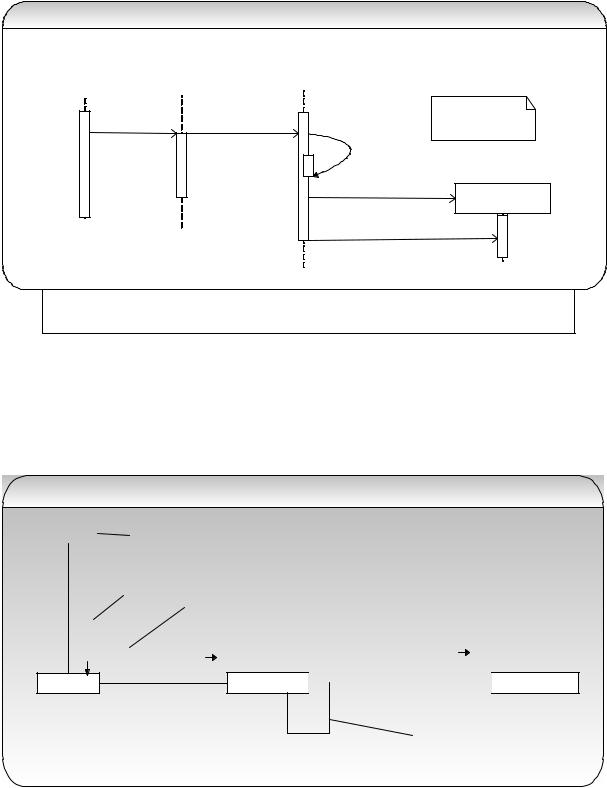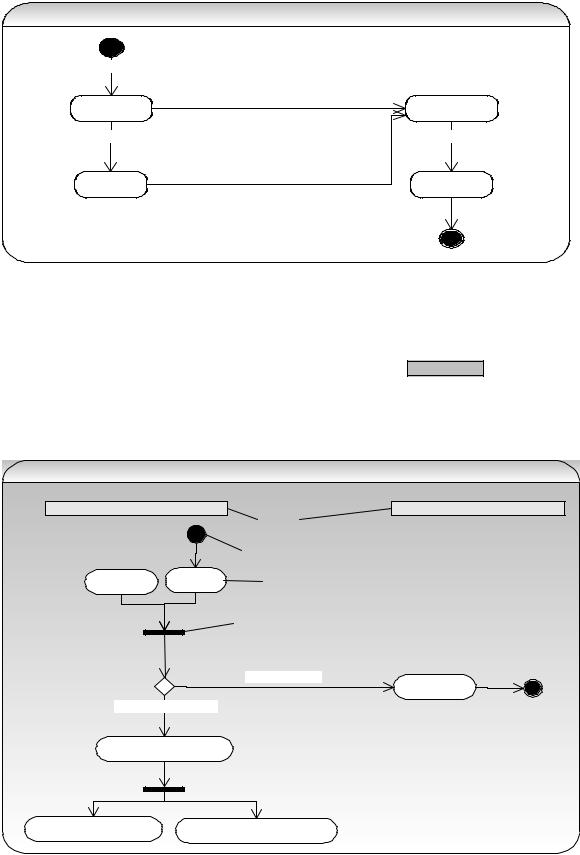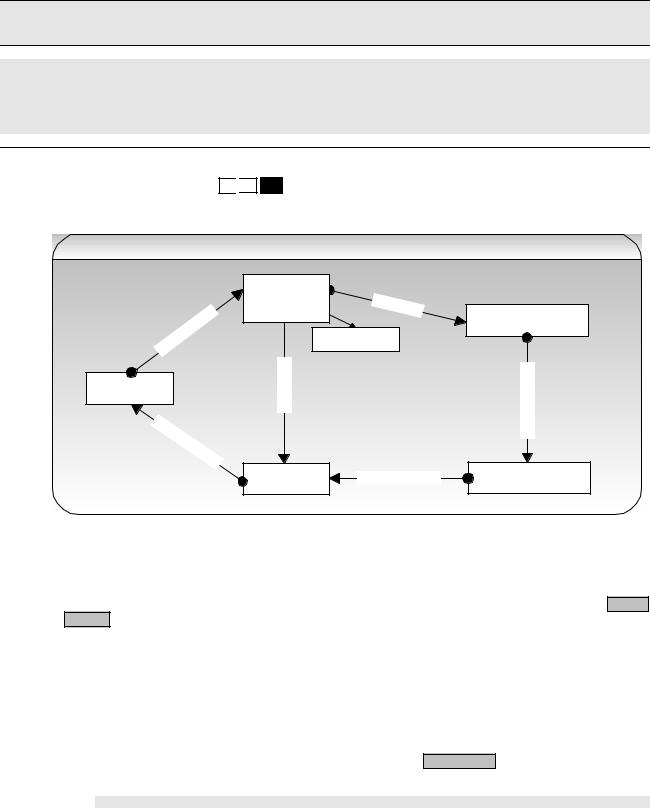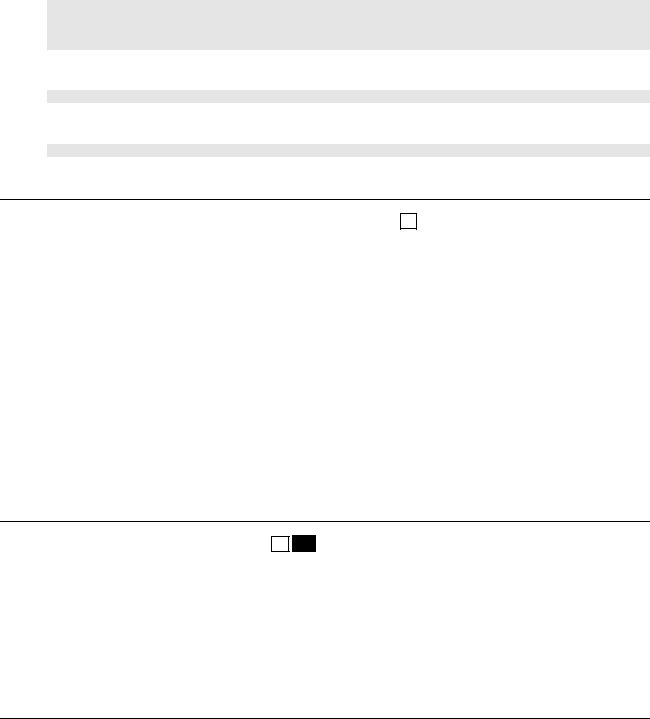
Java_J2EE_Job_Interview_Companion
.pdf


212 |
Enterprise – RUP & UML |
|
S ta te c h a rt D ia g ra m |
/ g e t a n ite m |
|
|
/ a ll ite m s a va ila b le |
C h e ck in g sta te |
D isp a tch in g sta te |
/ so m e ite m s n o t in sto ck |
/ d e live r |
|
/ ite m s re c e ive d |
w a itin g sta te |
D e live re d s ta te |
When to use statechart diagram?
Statechart diagrams are good at describing the behavior of an object across several use cases. But they are not good at describing the interaction or collaboration between many objects. Use interaction and/or activity diagrams in conjunction with a statechart diagram.
Use it only for classes that have complex state changes and behavior. For example: the User Interface (UI) control objects, Objects shared by multi-threaded programs etc.
Activity diagram: This is really a fancy flow chart. The activity diagram and statechart diagrams are related in a sense that statechart diagram focuses on object undergoing a transition process and an activity diagram focuses on the flow of activities involved in a single transition process.
|
|
Activity Diagram |
Order placement department |
dispatch department |
|
|
|
swim lane |
|
|
start |
check next item |
get first item |
activity |
|
|
join |
|
|
/ All item s in stock |
|
|
dispatch all items |
/ som e item s not in stock |
|
|
W ait for items to |
arrive in stock |
|
place an order with the supplier |
receive the order and enter into stock |

Enterprise – RUP & UML |
213 |
In domain modeling it is imperative that the diagram conveys which object (or class) is responsible for each activity. Activity diagrams can be divided into object swimlanes that determine which object is responsible for which activity. The swimlanes are quite useful because they combine the activity diagram’s depiction of logic with the interaction diagram’s depiction of responsibility. A single transition comes out of each activity, connecting to the next activity. A transition may join or fork.
When to use activity diagrams?
The activity and statechart diagrams are generally useful to express complex operations. The great strength of activity diagrams is that they support and encourage parallel behavior. The activity and statechart diagrams are beneficial for workflow modeling with multi-threaded programming.
Component and Deployment diagrams: A component is a code module. Component diagrams are physical diagrams analogous to a class diagram. The deployment diagrams show the physical configuration of software and hardware components. The physical hardware is made up of nodes. Each component belongs to a node.
|
Component and Deployment Diagram |
|
Ratailer J2EE Server |
|
Wholesaler J2EE application server |
Order Component |
Dispatch Component |
Order Component |
OrderIF |
DispathIF |
OrderIF |
Q 108: What is the difference between aggregation and composition? SD
 DC FAQ
DC FAQ
A 108:
|
|
Aggregation |
|
Composition |
|
||||
|
|
Aggregation: An association in which one class |
|
Composition: An association in which one class belongs to |
|||||
|
|
belongs to another class or a collection. This is a part |
|
another class or a collection. This is a part of a whole relationship |
|||||
|
|
of a whole relationship where the part can exist |
|
where the part cannot exist without the whole. If the whole is |
|||||
|
|
without the whole. |
For example: |
A line item is whole |
|
deleted then the parts are deleted. |
For example: |
An Order is a |
|
|
|
|
|
a line item is deleted |
|
|
|
|
|
|
|
and the products are the parts. If |
|
whole and the line items are the parts. If an order is deleted then all |
|||||
|
|
then the products need not be deleted. (no cascade |
|
the line items should be deleted as well (i.e. cascade deletes in |
|||||
|
|
delete in database terms) |
|
database terms). |
|||||
|
|
|
|
|
|
||||
|
|
Aggregations are not allowed to be circular. |
|
In a garbage-collected language like Java, The whole has the |
|||||
|
|
|
|
|
|
responsibility of preventing the garbage collector to prematurely |
|||
|
|
|
|
|
|
collect the part by holding reference to it. |
|||
|
|
|
|
|
|
|
|
|
|
|
|
|
|
|
|
|
|
|
|
Q 109: |
What is the difference between a collaboration diagram and a sequence diagram? |
SD |
|
DC |
A 109: |
You can automatically generate one from the other. |
|||
|
Sequence Diagram |
Collaboration Diagram |
|
|
The emphasis is on the sequence. |
The emphasis is on the object roles |
|
|
|
|
|
Reference: The above section on RUP & UML is based on the book UML Distilled by Martin Fowler and Kendall Scott. If you would like to have a good understanding of UML & RUP, then this book is recommended.


Enterprise – Struts |
215 |
•processActionPerform(req,res,action,form,mapping) Æ This method calls the execute method of the Action class which is where business logic is written.
ActionServlet class is the controller part of the MVC implementation and is the core of the framework. It processes user requests, determines what the user is trying to achieve according to the request, pulls data from the model (if necessary) to be given to the appropriate view, and selects the proper view to respond to the user. As discussed above ActionServlet class delegates the grunt of the work to the RequestProcessor and Action classes.
Workflow Logic (Action class): The Servlet dispatches the request to Action classes, which act as a thin wrapper to the business logic (the actual business logic is carried out by either EJB session beans and/or plain Java classes). The action class helps control the workflow of the application. (Note: The Action class should only control the workflow and not the business logic of the application). The Action class uses the Adapter design pattern (Refer Q11 in How would you go about … section). The Action class is a wrapper around the business logic. The purpose of the Action class is to translate the HttpServletRequest to the business logic. To use the Action class, subclass and overwrite the execute() method. The actual business logic should be in a separate package or EJB to allow reuse of business logic in a protocol independent manner (i.e. the business logic should be used not only by HTTP clients but also by WAP clients, EJB clients, Applet clients etc).
ActionForm class: Java representation of HTTP input data. They can carry data over from one request to another, but actually represent the data submitted with the request. The ActionForm class maintains the state for the Web application. ActionForm is an abstract class, which is subclassed for every input form model. The struts-config.xml file controls, which HTML form request maps to which ActionForm.
View (JSP): The view is a JSP file. There is no business or flow logic and no state information. The JSP should just have tags to represent the data on the browser.
The ExceptionHandler can be defined to execute when the Action class’s execute() method throws an Exception. For example
<global-exceptions>
<exception key="my.key" type="java.io.IOException" handler="my.ExceptionHandler"/> </global-exceptions>
When an IOException is thrown then it will be handled by the execute() method of the my.ExceptionHandler class.
The struts-config.xml configuration information is translated into ActionMapping, which are put into the ActionMappings collection. Further reading is recommended for a more detailed understanding.
Q.What is Struts Validator Framework?
A.Form data can be validated on the client side as well as on the server side using the Validator Framework, which was developed as a third-party add on to Struts. This framework generates the java script and it can be used to validate the form data on the client browser. Server side validation of your form can be carried out by subclassing your form class with DynaValidatorForm class. The Validator Framework uses 2 xml configuration files validator-rules.xml (defines reusable standard validation routines, which are usable in validator.xml) and validator.xml (defines validation applicable to a form bean).
Q.How will you display failed validation errors on JSP page?
A.Use the <html:/errors> tag.
Q.How will you turn on the client side validation based on validation.xml file?
A.Use the <html:javascript /> tag.
Q 111: What is a synchronizer token pattern in Struts or how will you protect your Web against multiple submissions?
DC
 DP
DP
A 111: Web designers often face the situation where a form submission must be protected against duplicate or multiple submissions, which breaks the normal control flow sequence. This situation typically occurs when the user clicks on submit button more than once before the response is sent back or client access a page by returning to the previously book marked page or client resubmits the page by clicking the back button/refresh button .

216 |
Enterprise – Struts |
The simplest solution that some sites use is that displaying a warning message “Wait for a response after submitting and do not submit twice.
In the client only strategy, a flag is set on the first submission and from then onwards the submit button is disabled based on this flag. Useful in some situations but this strategy is coupled to the browser type and version.
For a server-based solution the J2EE pattern synchronizer token pattern can be applied. The basic idea is to:
1.Set a token in a session variable on the server side before sending the transactional page back to the client.
2.The token is set on the page as a hidden field. On submission of the page first check for the presence of a valid token by comparing the request parameter in the hidden field to the token stored in the session. If the token is valid continue processing otherwise take other alternative action. After testing the token must be reset to null.
Refer Q 27 in Enterprise - JSP section under “Synchronizer token pattern”. The synchronizer token pattern is implemented in Struts using the following methods:
ActionServlet.saveToken(HttpRequest) and ActionServlet.isTokenValid(HttpRequest) etc
Q 112: How do you upload a file in Struts? SF
A 112: In JSP page set the code as shown below: CO
<html:form action="upload.do" enctype="multipart/form-data" name="fileForm" type="FileForm" scope="session">
Please select the file that you would like to upload: <html:file property="file" />
<html:submit />
</html:form>
In the FormBean set the code as shown below:
public class FileForm extends ActionForm { private FormFile file;
public void setFile(FormFile file){ this.file = file;
}
public FormFile getFile(){ return file;
}
}
Q 113: Are Struts action classes thread-safe? SF
 CI FAQ
CI FAQ
A 113: No. Struts action classes are not thread-safe. Struts action classes are cached and reused for performance optimization at the cost of having to implement the action classes in a thread-safe manner.
Q 114: How do you implement internationalization in Struts? SF
A 114: Internationalization is built into Struts framework. In the JSP page set the code as shown below: CO
<%@ taglib uri="/WEB-INF/struts-bean.tld" prefix="bean" %> <%@ taglib uri="/WEB-INF/struts-html.tld" prefix="html" %> <%@ taglib uri="/WEB-INF/struts-logic.tld" prefix="logic" %> <html:html locale="true">
<head>
<title>i18n</title>
</head>

Enterprise – Struts |
217 |
<body>
<h2><bean:message key="page.title"/></h2> </body>
</html:html>
Now we need to create an application resource file named ApplicationResource.properties.
page.title=Thank you for visiting!
Now in Italian, create an application resource file named ApplicationResource_it.properties.
page.title=Grazie per la vostra visita!
Finally, add reference to the appropriate resource file in the struts-config.xml.
Q 115: What is an action mapping in Struts? How will you extend Struts? SF
A 115: An action mapping is a configuration file (struts-config.xml) entry that, in general, associates an action name with an action. An action mapping can contain a reference to a form bean that the action can use, and can additionally define a list of local forwards that is visible only to this action.
Q. How will you extend Struts?
Struts is not only a powerful framework but also very extensible. You can extend Struts in one or more of the following ways:
Plug-In: Define your own Plug-In class if you want to execute some init() and destroy() methods during the application startup and shutdown respectively. Some services like loading configuration files, initializing applications like logging, auditing, etc can be carried out in the init() method.
RequestProcessor: You can create your own RequestProcessor by extending the Struts RequestProcessor. For example you can override the processRoles(req, res, mapping) in your extended class if you want to query the LDAP server for the security authorization etc.
ActionServlet: You can extend the ActionServlet class if you want to execute your business logic at the application startup or shutdown or during individual request processing. You should take this approach only when the above mentioned approaches are not feasible.
Q 116: What design patterns are used in Struts? DP FAQ
A 116: Struts is based on model 2 MVC (Model-View-Controller) architecture. Struts controller uses the command design pattern (Refer Q11 in How would you go about section) and the action classes use the adapter design pattern. The process() method of the RequestProcessor uses the template method design pattern (Refer Q11 in How would you go about section). Struts also implement the following J2EE design patterns
Service to Worker (Refer Q25 in Enterprise section).
Dispatcher View (Refer Q25 in Enterprise section).
Composite View (Struts Tiles) (Refer Q25 in Enterprise section)
Front Controller (Refer Q24 in Enterprise section).
View Helper (Refer Q25 in Enterprise section).
Synchronizer Token (Refer Q111 in Enterprise section).

218 |
Enterprise – Web and Application servers |
Enterprise - Web and Application servers
Q 117: What application servers, Web servers, LDAP servers, and Database servers have you used?
A 117:
|
Web Servers |
Apache, Microsoft |
IIS, Netscape, Domino etc |
|
|
|
|
|
|
|
Application Servers |
IBM WebSphere, BEA WebLogic, Apache Tomcat, Borland Enterprise Server, Fujitsu |
||
|
|
Interstage, JBoss, ATG Dynamo etc |
||
|
|
|
|
|
|
Portal servers |
Websphere Portal Server, JBoss Portal Server, etc |
||
|
|
|
|
|
|
LDAP Servers |
IPlanet’s directory server, SiemensDirX etc |
||
|
|
|
|
|
|
Database Servers |
IBM DB2, Oracle, SQL Server, Sybase, Informix |
||
|
|
|
|
|
|
|
|
|
|
Q 118: |
What is the difference between a Web server and an application server? SF |
FAQ |
|
A 118: |
In general, an application server prepares data for a Web server -- for example, gathering data from databases, |
||
applying relevant business rules, processing security checks, and/or storing the state of a user’s session. The term application server may be misleading since the functionality isn’t limited to applications. Its role is more as retriever and manager of data and processes used by anything running on a Web server. In the coming age of Web services, application servers will probably have an even more important role in managing service oriented components. One of the reasons for using an application server is to improve performance by off-loading tasks from a Web server. When heavy traffic has more users, more transactions, more data, and more security checks then more likely a Web server becomes a bottleneck.
|
Web Server |
Application Server |
|
|
Supports HTTP protocol. When a Web server receives an |
Exposes business logic and dynamic content to a client |
|
|
HTTP request, it responds with an HTTP response, such |
through various protocols such as HTTP, TCP/IP, IIOP, JRMP |
|
|
as sending back an HTML page (static content) or |
etc. |
|
|
delegates the dynamic response generation to some other |
|
|
|
program such as CGI scripts or Servlets or JSPs in an |
|
|
|
application server. |
|
|
|
|
|
|
|
Uses various scalability and fault-tolerance techniques. |
Uses various scalability and fault-tolerance techniques. In |
|
|
|
addition provides resource pooling, component life cycle |
|
|
|
management, transaction management, messaging, security |
|
|
|
etc. |
|
|
|
|
|
|
|
|
|
Q 119: What is a virtual host? SF
A 119: The term virtual host refers to the practice of maintaining more than one server on one machine. They are differentiated by their host names. You can have name based virtual hosts and IP address based virtual hosts. For example
A name-based "virtual host" has a unique domain name, but the same IP address. For example, www.company1.com and www.company2.com can have the same IP address 192.168.0.10 and share the same Web server. We can configure the Web server as follows:
NameVirtualHost 192.168.0.10
<VirtualHost 192.168.0.10> ServerName www.company1.com DocumentRoot /web/company1
</VirtualHost>
<VirtualHost 192.168.0.10> ServerName www.company2.com DocumentRoot /web/company2
</VirtualHost>

Enterprise – Web and Application servers |
219 |
In this scenario, both www.company1.com and www.company2.com are registered with the standard domain name service (DNS) registry as having the IP address 192.168.0.10. A user types in the URL http://www.company1.com/hello.jsp in their browser. The user's computer resolves the name www.company1.com to the IP address 192.168.0.10. The Web server on the machine that has the IP address 192.168.0.10, so it receives the request. The Web server determines which virtual host to use by matching the request URL It gets from an HTTP header submitted by the browser with the “ServerName” parameter in the configuration file shown above.
Name-based virtual hosting is usually easier, since you have to only configure your DNS server to map each hostname to a single IP address and then configure the Web server to recognize the different hostnames as discussed in the previous paragraph. Name-based virtual hosting also eases the demand for scarce IP addresses limited by physical network connections [but modern operation systems support use of virtual interfaces, which are also known as IP aliases]. Therefore you should use name-based virtual hosting unless there is a specific reason to choose IP-based virtual hosting. Some reasons why you might consider using IPbased virtual hosting:
Name-based virtual hosting cannot be used with SSL based secure servers because of the nature of the SSL protocol.
Some operating systems and network equipment implement bandwidth management techniques that cannot differentiate between hosts unless they are on separate IP addresses.
IP based virtual hosts are useful, when you want to manage more than one site (like live, demo, staging etc) on the same server where hosts inherit the characteristics defined by your main host. But when using SSL for example, a unique IP address is necessary.
For example in development environment when using the test client and the server on the same machine we can define the host file as shown below:
UNIX user: /etc/hosts
Windows user: C:\WINDOWS\SYSTEM32\DRIVERS\ETC\HOSTS
127.0.0.1localhost
127.0.0.1www.company1.com
127.0.0.1www.company2.com
[Reference: http://httpd.apache.org/docs/1.3/vhosts/]
Q 120: What is application server clustering? SI
A 120: An application server cluster consists of a number of application servers loosely coupled on a network. The server cluster or server group is generally distributed over a number of machines or nodes. The important point to note is that the cluster appears as a single server to its clients.
The goals of application server clustering are:
Scalability: should be able to add new servers on the existing node or add new additional nodes to enable the server to handle increasing loads without performance degradation, and in a manner transparent to the end users.
Load balancing: Each server in the cluster should process a fair share of client load, in proportion to its processing power, to avoid overloading of some and under utilization of other server resources. Load distribution should remain balanced even as load changes with time.
High availability: Clients should be able to access the server at almost all times. Server usage should be transparent to hardware and software failures. If a server or node fails, its workload should be moved over to other servers, automatically as fast as possible and the application should continue to run uninterrupted. This method provides a fair degree of application system fault-tolerance. After failure, the entire load should be redistributed equally among working servers of the system.
[Good read: Uncover the hood of J2EE clustering by Wang Yu on http://www.theserverside.com ]
Q 121: Explain Java Management Extensions (JMX)? SF
A 121: JMX framework can improve the manageability of your application by


 confirm : Confirmation
confirm : Confirmation
